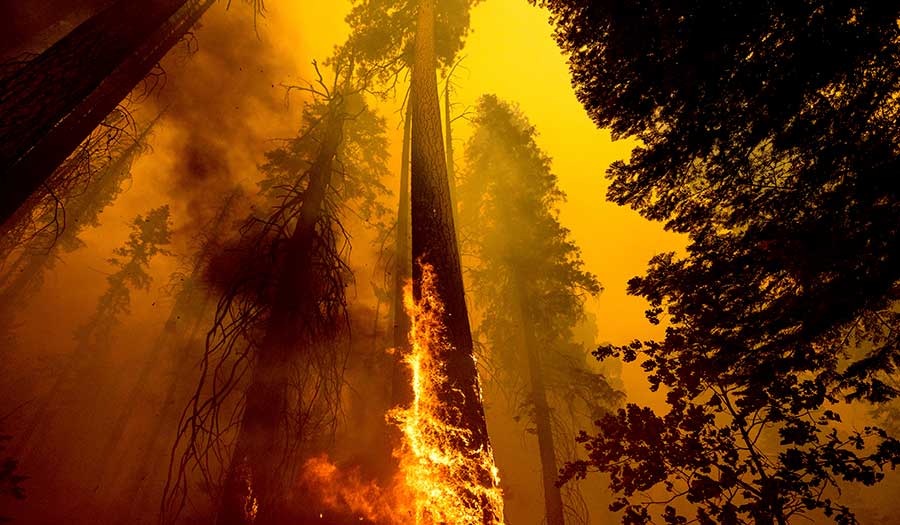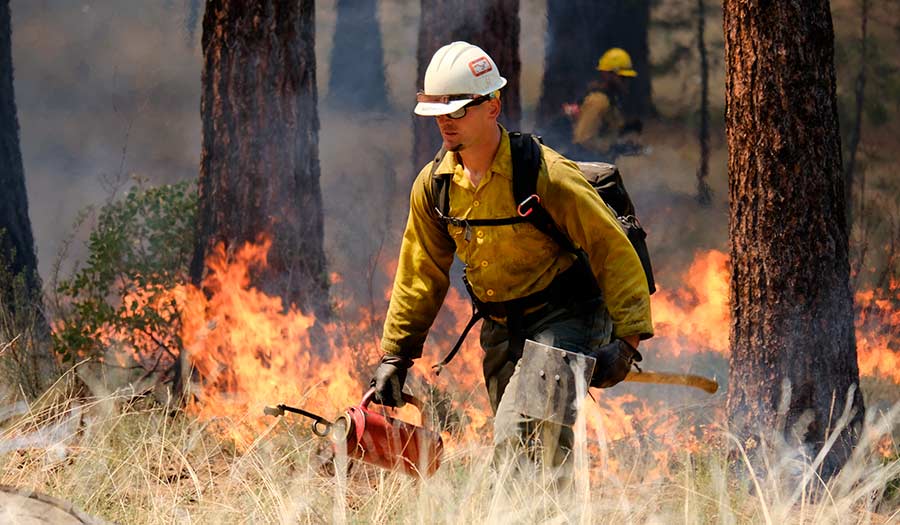 AP/Noah Berger
AP/Noah Berger
World News Desk
Learn the why behind the headlines.
Subscribe to the Real Truth for FREE news and analysis.
Subscribe NowLOS ANGELES (AP) – Lightning-sparked wildfires killed thousands of giant sequoias this year, leading to a staggering two-year death toll that accounts for up to nearly a fifth of Earth’s largest trees, officials said Friday.
Fires in Sequoia National Park and surrounding Sequoia National Forest tore through more than a third of groves in California and torched an estimated 2,261 to 3,637 sequoias, which are the largest trees by volume and date back to ancient civilizations.
Nearby wildfires last year killed an unprecedented 7,500 to 10,400 giant sequoias that are only native in about 70 groves scattered along the western side of the Sierra Nevada range. Losses now account for 13 to 19 percent of the 75,000 sequoias greater than 4 feet in diameter.
Blazes so intense to burn hot enough and high enough to kill so many giant sequoias—trees once considered nearly fire-proof—is the result of hotter droughts combined with a century of fire suppression that choked forests with thick undergrowth.
“The sobering reality is that we have seen another huge loss within a finite population of these iconic trees that are irreplaceable in many lifetimes,” said Clay Jordan, superintendent of Sequoia and Kings Canyon National Parks. “As spectacular as these trees are we really can’t take them for granted. To ensure that they’re around for our kids and grandkids and great grandkids, some action is necessary.”
California has seen its largest fires in the past five years. Last year set a record for most acreage burned and this year, so far, is running second.
Tree deaths this year might have been worse if heavy rain and snow October 25 had not dampened the fire. Fires burned from August last year into January.
After last year’s Castle and SQF Complex fires took officials by surprise, extraordinary measures were taken to save the largest and oldest trees this year.
The General Sherman tree—the largest living thing on Earth—and other ancients that are the backdrop for photos that rarely capture the grandeur and scale of the giant sequoias were wrapped in foil blankets.
A fire-retardant gel was dropped on canopies that can sit above 200 feet tall. Sprinklers watered trunks and flammable matter was raked away from trees.
The measures helped spare the Giant Forest, the premiere grove of massive trees in the park, but the measures could not be deployed everywhere.
The bulk of the Suwanee grove in the park burned in extreme fire in the Marble Fork of the Kaweah River drainage. The Starvation Complex of groves in Sequoia National Forest was largely destroyed.
The greatest amount of damage was done in Redwood Mountain Grove in Kings Canyon National Park. The inferno became so intense it created a fire cloud that whipped up 60 mph winds.
A fire ecologist accurately predicted the areas that would burn hottest, but nothing could be done in such erratic conditions to save trees in the second-largest grove, said Christy Brigham, chief of resource management and science for the parks.
“That’s even more heartbreaking to me that we knew it and we couldn’t take action to protect it,” Dr. Brigham said.
Groves with the worst damage stand like timber graveyards with blackened trunks soaring high in the sky. Canopies have faded from vibrant green to a rusty shade. Many damaged trees are expected to perish in three to five years.
Save the Redwoods League, which lost the Waterfall tree—one of the world’s largest—in 2020, suffered losses this year in its Red Hill Grove.
Not all the news in the park’s report on the fires was bleak.
While flames burned into 27 groves and large numbers of trees were incinerated, a lot of low-intensity fire that sequoias need to thrive will clear out vegetation and the heat from flames will open cones so they can spread their seeds.
There was also less damage in many of the groves where the park has routinely used prescribed fire to clear out accumulated vegetation under cooler and more humid conditions. Those successes emphasized the need to expand that work and, where that is too risky, begin thinning forests.
However, areas where fire burned so hot that seeds were killed and trees cannot regenerate may need additional help. For the first time, the park is considering planting seedlings to preserve the species.
If seedlings are planted, though, it will take hundreds of years to replace the trees that were lost.
- Real Truth Magazine Articles
- WEATHER & ENVIRONMENT
 Wildfires: Why Is Each Season Worse than the Last?
Wildfires: Why Is Each Season Worse than the Last?
More on Related Topics:
- With Sewage Gushing into Sea, U.S. and Mexican Border Towns Plead for Help
- Mass Fish Death in Mexico’s Chihuahua State Blamed on Severe Drought
- It Is So Hot in Mexico, Howler Monkeys Are Falling Dead from the Trees
- Too Much Water, and Not Enough: Brazil’s Flooded South Struggles to Access Basic Goods
- E-waste Is Overflowing Landfills. At One Sprawling Vietnam Market, Workers Recycle Some of It


